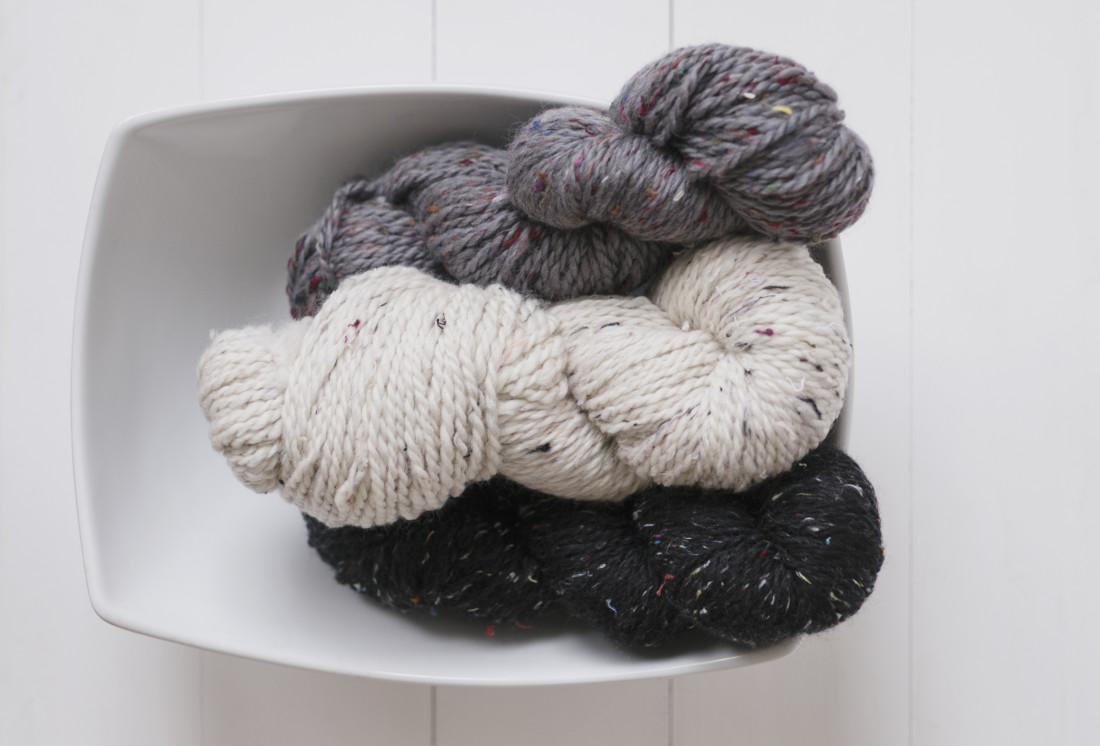Yoga pants get a bad rap. They’re the spandex scapegoat for sloth, attract more than their fair share of unwanted attention, and are now accused of melting polar ice caps.
“Microfibers come off polyester clothes in the washing machine, and those particles pollute waterways,” says Grace Gouin, strategist at Echoview Fiber Mill in Weaverville. Streams are so loaded with the synthetic stuff that, in theory, fish are a certain percent yoga pants.
But here’s the thing: Almost all clothing is less than eco-friendly. Gouin says that, second to oil, apparel is the most unsustainable industry out there. Just think about how your socks were made — the process likely required a journey across the Atlantic followed by transport in a few semi-trailer trucks. Talk about a carbon footprint.
To do its part to help break that cycle, Echoview has pioneered an in-house production method. In brief, alpacas and sheep get sheered less than 3 miles down Jupiter Road, raw fiber enters the textile mill’s ground floor and a sweater is made to order on the second level.
But the company is taking it a step further and asking that artists send scraps. A new product, named Yarn Collective in honor of the indie-baroque band Animal Collective, recycles unused fabric morsels. Gouin calls these angora gobbets “yarn barf.”
Echoview processes several boxes of fabric tidbits each week. Most come from the pompom market. “There are so many pompom makers on Instagram,” says Gouin. Emily Felix, owner of Reunion Yarn in Chattanooga, Tenn., sent the first 30-pound bag. She’s also credited with coining the vomit-related term.
So, how does one go from shredded flotsam to skein? Amalia Fragaso is the yarn developer, and she’s knit together a process that could also be considered scientific were it not for the first step. In the beginning, she pours out the scraps and sorts loosely by shade. There’s no time to nitpick here, so she separates by dark, bright and neutral colors. She then uses a carder — a spinning tool with bristles — to weave pompom fluff into merino.
“I lay wool out on the belt and add sprinkles,” says Fragaso. Both get blended together to make roving, or thick yarn.
Trimming out the kinks required trial and error. Measuring by weight, Fragaso toyed with 15 and 20 percent yarn barf. Both proved too nubby. Cloth oddments overpowered the wool. She finally found a sweet spot at 10 percent.
The final product is big on texture, low on itchiness. But because the yarn is bulky — it’s more like ziti when the knitting machine likes angel hair, says Gouin — Echoview is only selling it by the skein. It comes in black, gray and white, and is available for purchase online.
Though it may not be the best material for yoga pants, it does make a good old-fashioned sweater (for which undershirt is required). Plus, it’s not choking out trout and ramping up global temperatures.
“You have to be the change you want to see,” says Gouin. “So, you can either look at the unsustainable apparel industry and get disappointed or do it the right way.”
Learn more at echoviewnc.com




Before you comment
The comments section is here to provide a platform for civil dialogue on the issues we face together as a local community. Xpress is committed to offering this platform for all voices, but when the tone of the discussion gets nasty or strays off topic, we believe many people choose not to participate. Xpress editors are determined to moderate comments to ensure a constructive interchange is maintained. All comments judged not to be in keeping with the spirit of civil discourse will be removed and repeat violators will be banned. See here for our terms of service. Thank you for being part of this effort to promote respectful discussion.